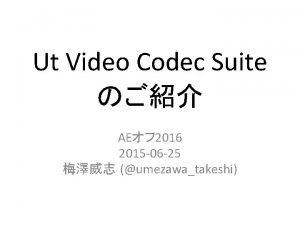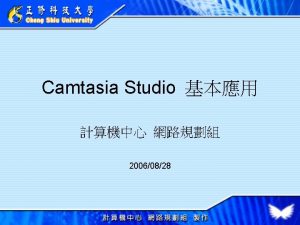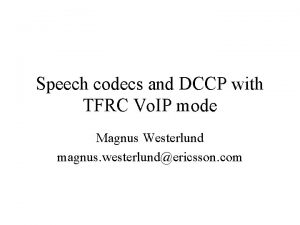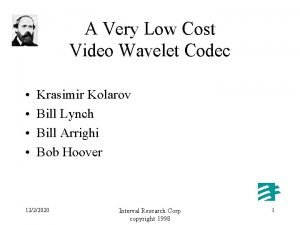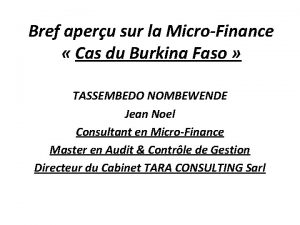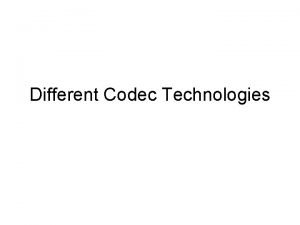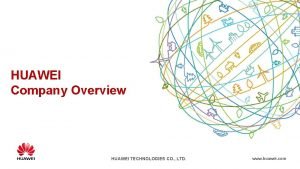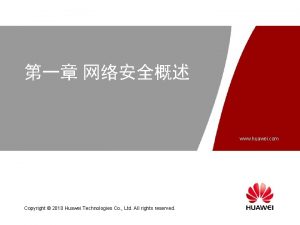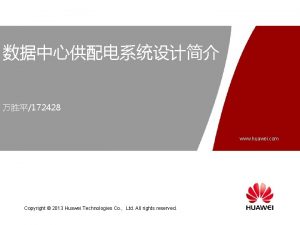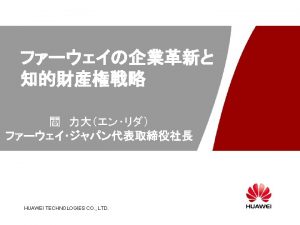Insights into Future Video Codec Huawei Technologies 2014













- Slides: 13

Insights into Future Video Codec Huawei Technologies 2014. 10. 21

Contents 1. 2. Video 2020—Mobility and Sociality Requirements for Future Video Codec Copyright© 2014 Huawei Technologies Co. , Ltd. All Rights Reserved. 2

Landscape of Video 2020 Mobility Video. Sharing Instagram Event. Time Streaming Surveillance Conference Broadcasting Sociability l l l Mobility and Sociality are the two driving forces for new video based applications. With the development of Smart and wearable personal devices, mobile video applications will become more and more important. The easy-to-use mobile and social video applications will generate much more video data than traditional streaming/broadcasting video. Video surveillance will be more pervasive, which has generated more video than youtube (Dropcam, 2013). Not video call or face time, but Event Time, to show your friend what you are seeing. Copyright© 2014 Huawei Technologies Co. , Ltd. All Rights Reserved. 3

Reality : Powerful Devices vs Slow Networks Cisco VNI 2014: By 2018, mobile video will represent 69% of global mobile traffic (up from 53% in 2013). Citrix Mobile Analytics Report Feb. 2014: On LTE networks, mobile videos stall for an average of 15 seconds per 60 seconds of video. Source : Mobile Video Report 2014 Q 3 , Joint Lab of Huawei m. Lab and Sohu Video. 100% 80% 0. 70% 17. 70% 2. 80% 36. 50% 720 p+ 60% 40% 81. 60% 20% 480 p 60. 70% 360 p- 0% 3 G l l 4 G In cellular networks, more than 50% bandwidth is consumed by video and will be more in future But the main-stream video quality is not better than 360 p Current mobile networks can not support good Qo. E video services Network bandwidth is still the bottleneck for massive mobile video services Copyright© 2014 Huawei Technologies Co. , Ltd. All Rights Reserved. 4

Contents 1. Video 2020—Mobility and Sociality 2. Requirements for Future Video Codec Copyright© 2014 Huawei Technologies Co. , Ltd. All Rights Reserved. 5

Co-existence of 3 G, 4 G and 5 G@2020 The current user and network model in downtown area ü ü User Model Network Model ü ü ü 40000 users per km 2 Peak concurrency of video users: 5% [Revenue] 300 m between access point 10 cells per km 2 [Cost] 30~100 MHz frequency bandwidth Densest RAN distribution in downtown area- CMCC 300 m 300 m 300 m Trade off between cost of network deployment and Qo. E LTE 386 Mbps/km 2 LTE-A 2. 6 Gbps/km 2 4. 5 G 10 Gbps/km 2 5 G 1000 Gbps/km 2 2014 2016 2019 2023 l l LTE and its evolvement will be the main way for MBB streaming in next decade How to improve revenue while control the cost is important Copyright© 2014 Huawei Technologies Co. , Ltd. All Rights Reserved. 6

Cost down while Qo. E up Network Avg. DL Rate/Cell Resolution @ Frame Rate Source Rate (Mbps) AVC HEVC (bandwidth requirements) AVC HEVC (Users/Cell) 3 G 2 Mbps@ 5 MHz 416 x 240@10 34 350 Kbps 175 Kbps 5 10 LTE 38. 6 Mbps@ 20 MHz 640 x 480@30 105 1 Mbps 500 Kbps 40 80 832 x 480@30 137 1. 5 Mbps 750 kbps 25 50 260 Mbps@ 100 MHz 1280 x 720@30 316 3 Mbps 1. 5 Mbps 86 172 1920 x 1080@30 712 8 Mbps 4 Mbps 32 65 LTE-A l l l HEVC provides better solution with less cost per bit At the same time, smaller video size help to conquer fluctuation of wireless network and reduce the times of video stall Also HEVC helps to improve resolution of video, which is important for some advanced video based mobile applications, such as insurance company’s investigation of a car accident. Copyright© 2014 Huawei Technologies Co. , Ltd. All Rights Reserved. 7

Call afore a new hero! • 25% compression improvement is not enough for a new codec • Bring forward a wave for High Quality Mobile Video LTE 386 Mbps/km 2 LTE-A 2. 6 Gbps/km 2 4. 5 G 10 Gbps/km 2 Users Concurrency 2% (80/Cell) 5% (200/Cell) 10% (400/Cell) Avg. DL/UL BW/User 0. 48 Mbps/0. 16 Mbps 1. 3 Mbps/0. 43 Mbps 2. 5 Mbps/0. 8 Mbps 12/4 65/21 250/125 UL BW ~= 1/3 DL BW DL/UL Users/Cell for FHD quality@HEVC(4 Mbps) l l l 5 G 1000 G/km 2 2 X LTE will fail to meet the growing demand for mobile video. With the improvement of Qo. E and user bandwidth, more and more user will be using the mobile video services. It is expected that LTE-A and the so called 4. 5 G will be the most popular MBB access points. A HD level mobile video quality is expected for mobile video services. A 2 X better than HEVC codec will be basic for really massive video applications and services over Mobile Network for the next decade. Copyright© 2014 Huawei Technologies Co. , Ltd. All Rights Reserved. 8

Needs for a dilemma-breaker! A: Improve Revenue of CSP ↑ B: Improve User Experience ↑ C: Reduce Cost per Bit ↓ Make New Services Possible Copyright© 2014 Huawei Technologies Co. , Ltd. All Rights Reserved. 9

Balance equation: 2 X Performances@2 X Complexities Improvement of gates per unit 7. 0 2006 2008 2010 2012 2014 2016 2018 2020 6. 0 Cortex-A 53 5. 0 4. 0 3. 0 2. 0 Future Codec Cortex-A 15 Cortex-A 9 Cortex-A 7 Cortex-A 5 Chip Cost Power Consumption HEVC AVC 1. 0 65 nm 40 nm 28 nm 20 nm 16 nm 14 nm 12 nm 10 nm Chip Manufacturing Technology Improvement l l l In the past decade, chip manufacture technologies have been improved greatly. Mobile processors are getting higher frequency and cores. Mobile device consumers are aware of power efficiency and functionalities greatly. The improvement of chip technologies will provide more computing ability for higher level functions while keeping the power consumption at a acceptable level. The development of future codec should take chip tech. into consideration. Copyright© 2014 Huawei Technologies Co. , Ltd. All Rights Reserved. 10

Performance vs. Royalty Free • Video Codec is a enabling technology for video services. • For the current mobile video applications, cost per video bit is still too high for massive video services market which are blocking the development of innovation of video based mobile applications. • It is important to have a better video codec for mobile video services first. • Healthy balance between the royalty cost and the investment of new codec technologies is important. Copyright© 2014 Huawei Technologies Co. , Ltd. All Rights Reserved. 11

Thank You. www. huawei. com Copyright © 2010 Huawei Technologies Co. , Ltd. All Rights Reserved. The information contained in this document is for reference purpose only, and is subject to change or withdrawal according to specific customer requirements and conditions. © 2010 华为技术有限公司 版权所有 本资料仅供参考,不构成任何承诺及保证

Original questions • • • What will be the applications with highest amount of video data delivery 5 -10 years from now? Do you see market segments where HEVC may not be successful due to lack of functionality? How much additional compression (compared to HEVC) do you foresee to be needed for your market(s)? What are the desirable frame rates and resolutions? How would it affect your business (and in what time frame) if a new video codec would deliver 25% reduction in data rate for the same video quality compared to HEVC? What should be “the bar” to surpass to make a new standard? (in terms of tradeoff of compression benefit versus complexity, compatibility with existing designs, etc. ) What would change if the industry uses the new codec as (partly or totally) royalty-free? Copyright© 2014 Huawei Technologies Co. , Ltd. All Rights Reserved. 13
